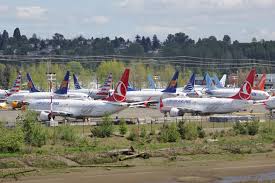Is the 737 Max safe?

November 21, 2019
You may have heard of the Boeing 737 Max crashes, and wondered if you were safe, some people were seriously worried about dying in one of these, and it’s not like plane crashes can be taken lightly. No one wants to die in a crash after falling from the sky in a metal tube. But were you ever really at risk of dying in one of these planes?
The cause behind both of these accidents was a system built into the 737 Max called MCAS (Maneuvering Characteristics Argumentation System). The system was put into place because of the larger engines on the plane, which had to be moved further forward. So this offset the center of mass and thrust on the plane, causing it to lean forwards more.
Why did Boeing put the engines further forward? Could they have just avoided putting this system in the plane, why did they need bigger engines?
The reason they put on the bigger engines was because of competition between the major Aircraft manufacturers —Boeing, Airbus, Embraer, and Bombardier. New competitors seem the be on the verge of stealing some of the market shares, but for now, if you are flying, odds are you are on a plane manufactured by one of these companies. So as you can imagine they are all fighting for more market share, by creating a better, more efficient plane, and cheaper prices. The two main competitors are Boeing and Airbus. In 2010 Airbus launched the A320 Neo (New Engine Option) Family which airlines loved, it was more efficient than old A320s and 737s. Boeing needed to make something to sell to compete with the A320 Neos. Enter the 737 Max, a plane made to be more efficient, longer range, and faster than any other narrow-body airplane with larger engines than the old 737s. Everything seems to be good so far. Where did things go wrong?
The issue with bigger engines is that the 737 was made with a non-circular engine shape, it flattens out at the bottom. This was made in order for the 737 to have lower ground clearance, but when larger engines are put on, then they can hit the ground. So Boeing decided to put the engines further forward on the wing. But this offsets the center of gravity further forward, meaning that the plane nose would start to point downward, requiring new training for pilots, but why would an airline invest in all-new training for pilots, when they could just upgrade to an A320, which requires no extra training for pilots. So the solution to this is to add something to the plane that would make it the same as the old 737s. That is the role of the MCAS.
Boeing opted to do a short training session for pilots, but they neglected to mention the MCAS. Unfortunately, on Oct. 29, a 737 Max Lion Air Flight (Indonesia) crashed into the sea killing 189 people. On March. 10 157 people died on an Ethiopian Airlines flight.
These were discovered to be a failure of the MCAS system, which lead to an immediate grounding of all 737 Maxs worldwide. Unfortunately, this lead to major problems with canceled flights and a damaged reputation for Boeing. Hopefully, this can be fixed, and the 737 Max can fly again, but it will never be as successful as Boeing wants it to be, because of the reputation it has because of the crashes.











